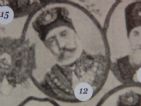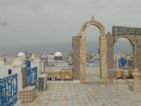
Bey´s Palace
Comparisson reports are under license of:

Lo que dice el Arxiduc:
“Only a few soldiers are found in front of the palace entrance. From outside, the palace is simple, painted white, with numerous small windows. The patio is also simple, small, with an almost ugly staircase, though some rooms upstairs are elegant. Some have stucco-decorated walls, others have a bright yellow ceiling with the prettiest arabesques; some reflect a French style. Meetings were held here during the time of the Constitution, though the latter did not prevail for long as Arabs do not have a sense of political freedom and soon destroyed this Liberal work in blind rage. One of the palace’s rooms is built like a bridge above the street. Both sides offer a view of noisy bazaars through iron bars. There is the Bey, seated during three days of Ramadan, spending nearly the entire day looking at the crowd. He can only be seen in Tunis on these days. It is the only time of the year that he visits his palace in the city, and he generally only spends one night there.”
Archduke Ludwig Salvator of Austria, Tunis. Ein bild aus dem nordafrikanischen leben, Heinrich Mercy, Prague, 1870
Datos proyecto Nixe III:
We were able to visit one of the Bey’s palaces in Tunis. Today, it houses a large bazaar. We noticed a large room painted in yellow tones which is now used to sell rugs. In another room, also full of rugs, we were told that it used to be the Bey’s original bedroom.























